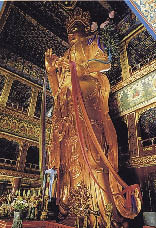|
The Largest Wooden Statue
In 1956, eight chests containing more than 1,000 wooden figurines were discovered in the Dingling underground palace – one of the 13 Ming tombs in Beijing – of Emperor Wanli (1563-1620). Most, however, had rotted to the point of falling apart when touched. Few burial woodcarvings survive centuries underground. Those enshrined in temples, however, last longer and are generally in better condition.
Religious statues feature fine workmanship and high quality materials. Examples of masterpieces in this genre include the Avalokitesvara statue in Chengde's Puning Temple, and the huge Maitreya in Beijing's Yonghegong Lamasery.
The Puning Temple, a World Cultural Heritage site, was built from 1755 to 1759 during the Qing Dynasty. It covers 33,000 square meters and combines the temple art of Han and Tibetan Buddhism. The gilded wooden Avalokitesvara statue, with its "one thousand eyes and one thousand arms," in the main hall is 27.21 meters tall, including the 1.22-meter-tall pedestal beneath it. The statue measures 15 meters across the waist and the head constitutes 5.4 tons of the statue's full 110-ton weight. The Guinness Book of World Records lists the Avalokitesvara as the largest wooden statue in existence.
This huge figure has a complex wooden structure. An inner framework of 15 columns extending from the lotus seat to the waist supports the top section, and a 22-meter-tall central pillar made of two cypress logs reaching to the top of the head serves as its backbone. The Buddha's robes are carved out of wooden planks. The statue was hewn out of 125 cubic meters of pine, cypress, fir, elm and basswood timber before the actual sculpting began. The Avalokitesvara's exquisite proportions and fine carving makes it distinct among large Buddhist sculptures. The statue has 42 arms. Forty of them fan around the body, each with an eye in its palm and holding a different ritual utensil. The other pair is clasped before its chest in prayer. On the Avalokitesvara's head stands a 1.52-meter-tall statue of the Buddha of Infinite Light, teacher of Avalokitesvara.
The wooden Maitreya in the Yonghegong temple extends 18 meters above ground from its eight-meter-high underground base. The main section is carved out of a single white sandalwood log, and the Buddha is clothed in 1,100 meters of yellow silk. Yonghegong was the residence of Qing Emperor Yongzheng before his enthronement. As no one presumed to move into his former home after he began living in the Forbidden City, it was converted into a temple and named Yonghegong. Yongzheng's son and successor, Emperor Qianlong, wanted to build a Buddhist statue in the temple, but was unable to find a suitable timber. It is said that the Seventh Dalai Lama traded substantial treasures with Nepal in exchange for a three-meter-thick white sandalwood log in the 15th year of Qianlong's reign (1750), and arranged its transportation to Beijing via Tibet and Sichuan. Emperor Qianlong summoned experienced wood carvers from around the country to work on the statue in Beijing with imperial and Buddhist artisans. When completed, the statue was wrapped in straw and felt during the construction of Wanfu Hall, the largest in the temple, around it. The statue's exquisite headgear, tassels, gold bracelets and other gem-encrusted ornaments are characteristic of Tibetan Buddhist statues.
Crafters of Wooden Architecture
 |
|
The huge Maitreya Buddha in Beijing's Yonghegong Lamasery. |
China's ancient wooden architecture is perhaps even more impressive than its Buddhist woodcarvings. Many masterpieces still stand today, an outstanding example being the wooden pagoda in Shanxi's Yingxian County.
The pagoda was built in 1056 during the Liao Dynasty. It is composed of an inner structure of nine stories enclosed by an outer structure of five stories. Its multiple eaves incorporate 54 kinds of bracket unit in which not one nail was used. The pagoda weighs 7,400 tons and stands 67.31 meters tall. The world's tallest wooden structure, it is constructed entirely of wooden sections joined by tenon-mortise joints. This technique dates back to the Neolithic Age, and is a feature of the 7,000-year-old Hemudu Culture sites in the lower reaches of the Yangtze River. The tenon-mortises absorb outer forces, thus increasing the wooden structure's elasticity. This is a main reason why the Yingxian pagoda, which the Chinese government recently listed as a candidate for World Heritage status, still stands intact after 1,000 years.
|
